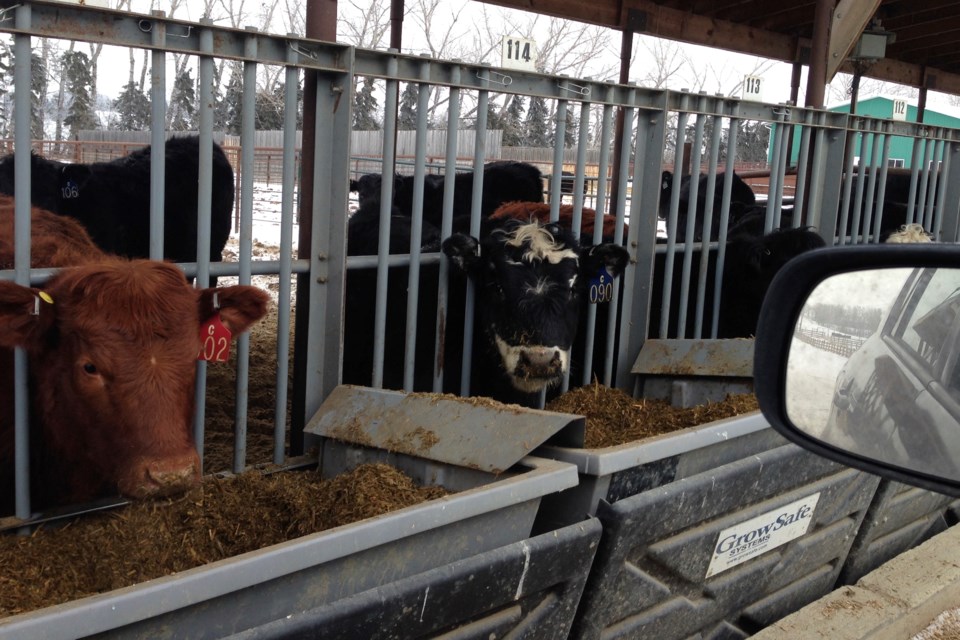The future of the beef breeding industry in western Canada will be genomics, says John Basarab, a research scientist with the University of Alberta and head of beef operations for Livestock Gentec.
“Our cattle in western Canada and Alberta are very well-adapted to their environment and their production system,” stated Basarab.“They are sustainable; they have sustained the test of time through many economic and environmental challenges.
“In saying that, it doesn’t mean you can’t improve further. That’s what we are trying to do – to find genomic tests and tools that help cattle producers produce cattle that are more profitable and more sustainable.”
Livestock Gentec is an Alberta Innovates Centre based at the University of Alberta. It was created in 2010 to bring the commercial benefits of genomics to the Canadian livestock industry.
“It essentially gathers together research scientists from Agriculture and Agri-Food Canada through the University of Alberta, and others nationally and internationally,” Basarab explained. “It works on genomic solutions to the livestock industry’s issues.”
Over the last 12 years Livestock Gentec has also worked closely with the Roy Berg Kinsella Research Ranch and Lacombe Research and Development Centre to develop a comprehensive DNA database consisting of over 13,000 purebred and crossbred beef cattle in Alberta– almost acting like an Ancestry.com for the Alberta cattle industry.
Having access to all this genomic data has allowed Livestock Gentec to develop a commercially available DNA test called Envigor HX, which is licensed to Neogen Canada.
With one DNA test, explained Basarab, a cattle producer can now know very quickly if an animal will likely be an efficient feeder, how much growth rate to expect, likely weaning weight, and various other factors which all contribute to profitability for beef producers and product quality for the Canadian meat packing industry.
The commercially available test is about 40-45 per cent accurate, which is good for a genetic test, said Basarab.
“That’s essentially equivalent to having 10 or 12 progeny records,” he explained. “You can imagine the cost and time it would take you to get 12 progeny records for feed intake … That would be very costly and time-consuming. Our database essentially allows a producer to take a hair or a tissue sample, and get those breeding values immediately on all traits.”
While the results sound like they might be helpful in making cattle management decisions at a farm level– particularly when deciding on which bulls to use as sires or which young heifers to keep back for replacement herds– Basarab said the Canadian beef cattle industry has lagged behind other livestock industries in its use of genetic testing.
According to Basarab, while the Canadian dairy cattle and pork industries have embraced genomics to help make management decisions for nearly 20 years, beef producers have only just begun considering more widespread use of genetic testing.
“But now it is becoming a much bigger thing,” he confirmed. “Just as an example, over the last year we have collected more (than) 10,000 DNA samples from beef producers. We have had them genotyped and produced molecular breeding values for them. So you can see there is investment by producers in time and money in collecting all these DNA samples. That’s a pretty good indiction that things are going to start to grow exponentially in the beef industry.”
Prior to this outburst of local genomic testing activity in 2021-2022, Basarab says most of the testing done by Neogen Canada using Livestock Gentec’s DNA multi-trait test in Alberta had largely been coming in from the purebred cattle breeding associations in an extremely limited way– in other words, “almost nil,” he stated.
This influx of testing is an exciting new development after years of genomic cattle research in Alberta, said Basarab, and he feels the sky is really the limit as to where this type of genomic testing goes in the beef cattle industry in the future. The next frontier for Livestock Gentec, he says, is advances in genomic testing to help cattle producers reduce their herds’ greenhouse gas emissions and lower their carbon footprint.
Up until now, most research dollars on this front have been spent on nutritional and management intervention. Basarab pointed out that feed efficiency in animals is certainly a heritable trait current genomic testing can provide insights on. But, he said, what if research facilities like his in partnership with the beef breeding industry could compile a database of animals which reveals actually how much methane they produce per cow?
According to Basarab, with a database like that, made up of a sufficient sample size, future genetic tests might be able to reveal which animals actually produce less methane in their bodies, and help farmers select breeding stock from among those animals.
“We could develop a breeding value for methane emissions,” he stated. “However, at this stage we haven’t done that yet … I have measured methane emissions and CO2 emissions from hundreds of cattle. So we know how to do it. However, that is very costly technology.”
Basarab said it would take a lot of cooperation from the beef industry to test the tens of thousands of animals necessary to create such a databasem, and a sustained and significant research investment to finance it.
“It takes investment, and the industry, society and government has to be interested in investing,” he said.



